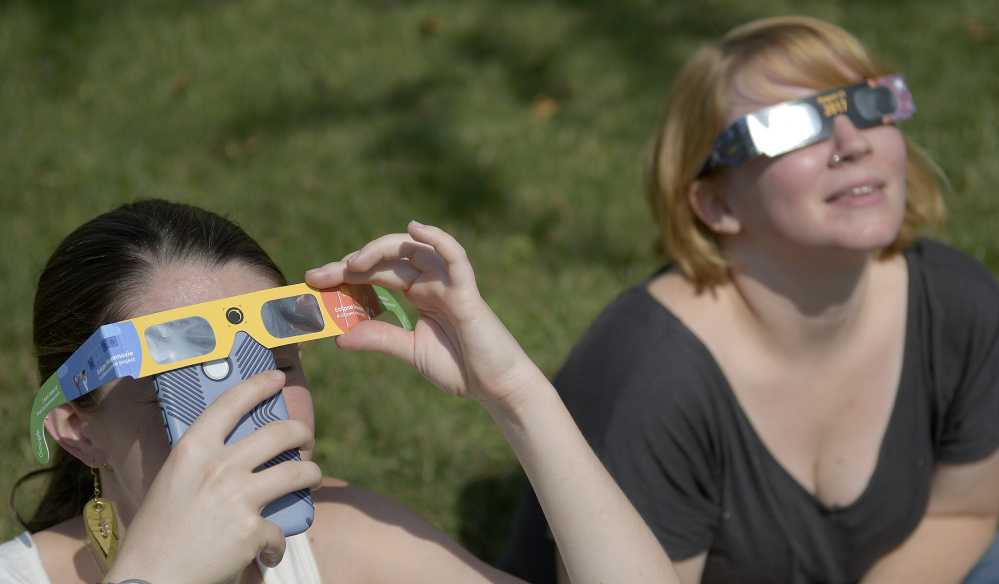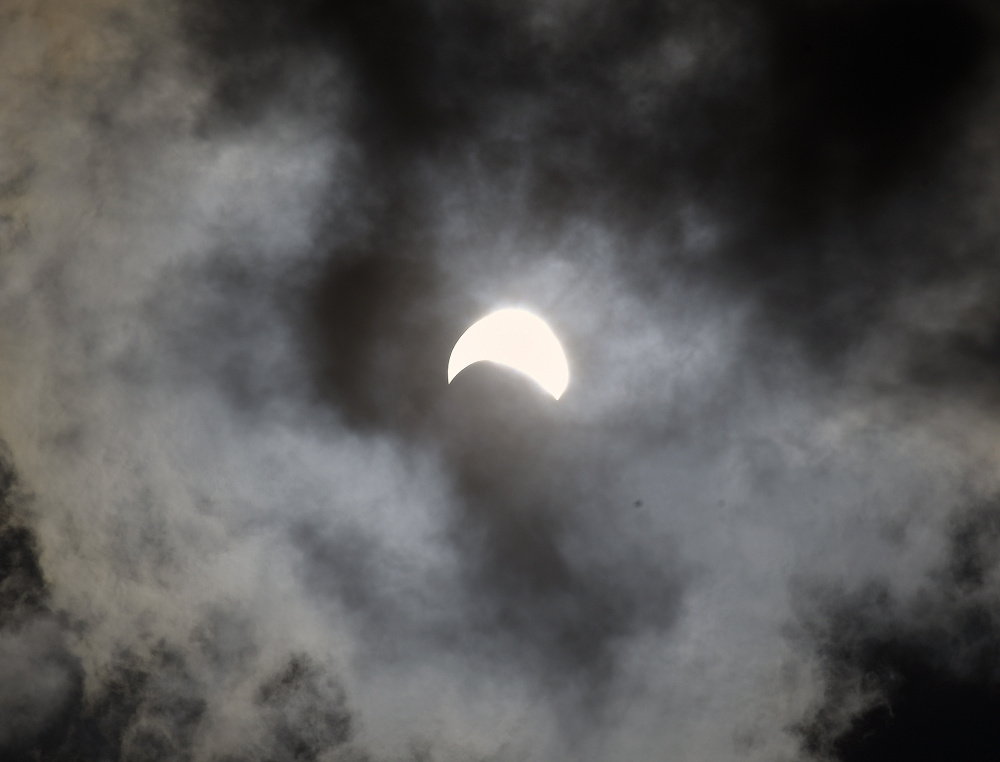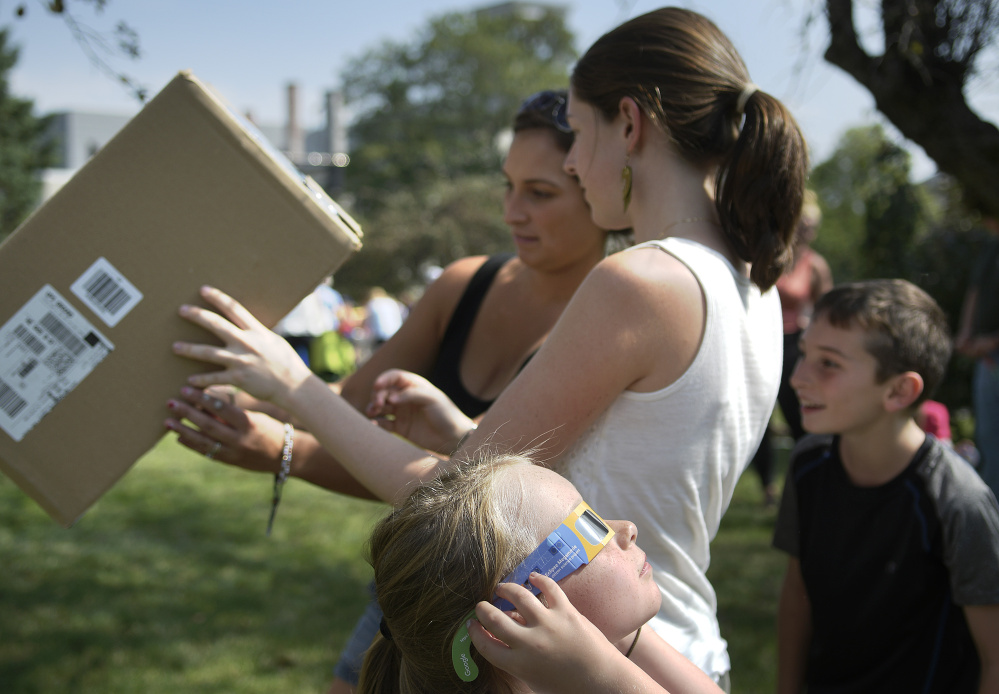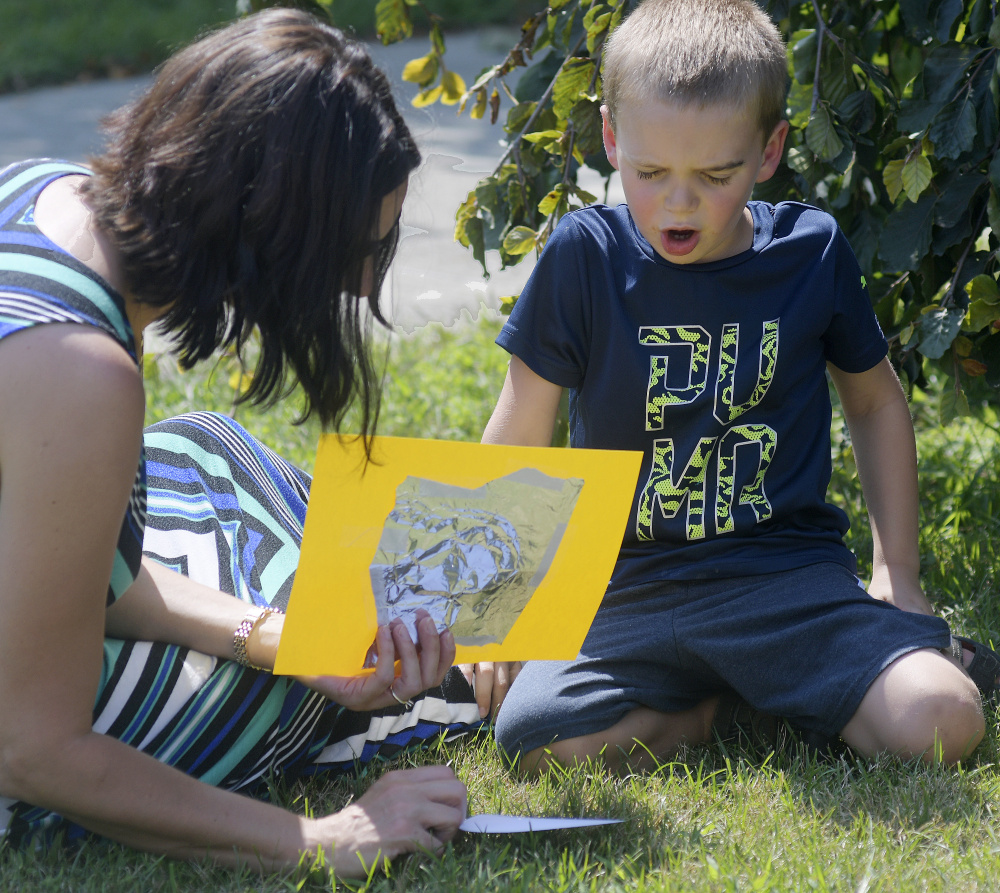AUGUSTA — Even at 5, Ethan Cotnoir can’t be fooled. The moon goes around the Earth and the Earth goes around the sun. And during an eclipse, the moon goes in the front of the sun and that makes a shadow on Earth.
He might not understand all the mechanics of astrophysics yet, but standing on the lawn of Lithgow Public Library, it turns out he knew all he needed to see one safely.
On Monday, the path of the coast-to-coast total solar eclipse passed far south of Maine, but those who were prepared and equipped here, like Ethan and his mother Jamie, got a chance to see forces far larger than humans and their influences at play.
The Cotnoirs came from Sidney and used a pinhole projector they made at the library from cardstock, foil and tape to track the progress of the moon by looking down at the shadow cast through the pinhole onto a sheet of paper.
Libraries across the region, including the Maine State Library, put together eclipse-related events and parties Monday.
The Cotnoirs were joined at Augusta’s library by about 250 others who stopped by to see the eclipse indirectly through a pinhole projector of their own making or directly at the interplay of sun and moon thanks to the eclipse glasses supplied by the library.
For the last week, the library’s phones have been ringing constantly as people started seeking out eclipse glasses in earnest as other sources dried up.
As Lithgow Public Library Director Elizabeth Pohl and her staff members handed out the glasses — extracting promises to share them from those who received them — about 20 minutes before the eclipse’s peak, they were worried they would run out if a lot of people showed up at the last minute.
“We have about 120 total,” Pohl said. “We ordered some, and then we ordered some more and then none were available.”
And that’s what drove the near-constant phone calls in the days leading up to Monday as people who couldn’t find them anywhere else turned to the library.
If Billy Leger had realized that a shortage would send people scrambling, he would have ordered a box to sell himself.
Leger brought his daughter Abby, 8, to the library to see the eclipse with her.
Growing up in Natick, Massachusetts, Leger saw about a half-dozen eclipses, mostly lunar eclipses, thanks to the planetarium at Natick High School.
“I wanted to experience it with her,” he said, looking around. “It’s an interesting gathering of people.”
Abby Leger came prepared for the pause before the action started, sitting on the lawn and reading “Adventures in Babysitting.”
“It’s nice of the library to make the materials and glasses available free,” he said.

The moon slips in front of the sun showing the corona of the sun during a complete eclipse in the middle of the path of totality in Sweetwater, Tenn., on Monday. The corona is the outer edge only visible within the 70 mile range that is called the path of totality.
At the one of the two tables set up outside, teen librarian Julie Olson offered instructions on making the projectors to adults and kids alike. Occasionally a breeze scattered materials sending everyone scrambling after paper and tacks. While keeping a general eye on the progress of individual projects, she kept a sharp eye on what happened to them after they were completed, because people were compelled to look through the pinhole at the sun.
“Don’t look at the sun directly,” Olson said repeatedly to each new wave of people passing through. “Never look at the sun!”
Along the path of totality that stretched from Oregon to South Carolina, the sun was entirely blocked by the moon bringing momentary darkness during the afternoon. In Maine, the moon covered only about 58 percent of the sun at the peak of the eclipse at 2:45 p.m.
Thanks to the solar glasses, Mary Lou Cona was able to see her first eclipse Monday. Cona was in Maine to visit her daughter, Sara Cotnoir, who lives in West Gardiner and found the viewing party via an internet search.
Cona would have seen a bigger impact from the eclipse if she had remained home in Seattle, but she had no regrets about seeing it in Maine, she said.
In fact, fewer places in the continental United States were farther away from the totality path than Maine, but that didn’t dim anyone’s enthusiasm.

The moon slips in front of the sun showing the corona of the sun during a complete eclipse in the middle of the path of totality in Sweetwater, Tenn., on Monday. The corona is the outer edge only visible within the 70 mile range that is called the path of totality. Sweetwater was in a unique spot to witness the entirety of the path of totality for more than two minutes. Only a 70 mile wide band stretched across the United States allowing for such a solar eclipse viewing.
Kalie Hess, of Augusta, and Fallon Sweeney, of Hallowell, tried out the pinhole projector for themselves, but it wasn’t long before they decided they could do better.
Hess, who works not far from the library at the Maine Primary Care Association, popped back to her office to pick up a large cardboard box. Inside one end, they taped a piece of white paper, and at the other they set in a piece of foil with a pinhole, making a sturdier version of the pinhole projector than everyone else had. The whole apparatus took about five minutes for them to make, Hess said, after looking it up on the internet.
While they pointed out the shadow to the kids nearby, they set aside the box in favor of the glasses to watch the peak.
A pronounced crescent marked the peak, and then gradually, more of the sun was revealed.
As the sun lost its cover, people started drifting away.
Olson said she brought a ream of paper out to make the projectors and estimated that probably 200 to 300 were made.
How many would she have to pick up after the excitement passed?
“Probably 200 to 300,” she said.
Jessica Lowell — 621-5632
Twitter: @JLowellKJ
Send questions/comments to the editors.






